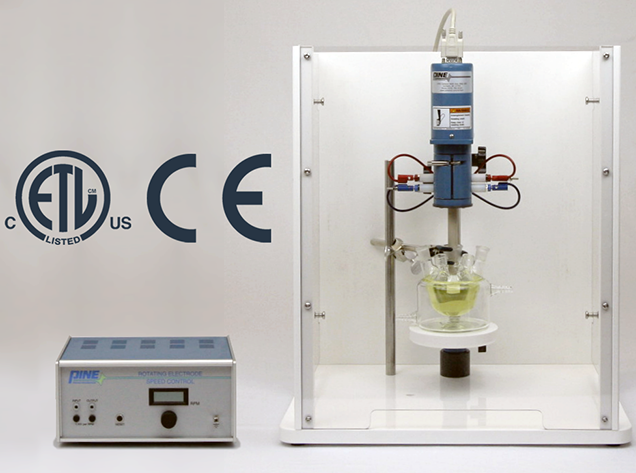MSR
00 
Introduction
The MSR rotating electrode is the most popularrotating electrode configuration worldwide. The MSR now includes both CE andETL marks. This flexible design may be usedwith Rotating Disk Electrodes (RDE), Rotating Ring-Disk Electrodes (RRDE) and RotatingCylinder Electrodes(RCE).
Adjustablerange from 50 to 10,000 RPM
Accuracywithin 1% of the reading display
CE and ETLmark
Silver-carbonbrush contacts. Red is for the disk, Blue is for the ring
Description
Electrodetips for this rotator are sold separately.
MAXIMUMROTATION RATE: Each electrode tip model used with the MSR rotator has a maximumrotation rate. Do not the exceed maximum rotation rate when working withrotating electrodes.
The MSR rotating electrode is the most popularrotating electrode configuration worldwide. The MSR now includes both CE andETL marks. This flexible design may be used with Rotating Disk Electrodes(RDE), Rotating Ring-Disk Electrodes (RRDE), and Rotating Cylinder Electrodes(RCE).
The Pine Research Instrumentation AFMSRCE rotatoris an electrochemical measuring instrument often used for fundamental researchon battery and fuel cell materials. This measuring instrument bears the CEMark and ETL Mark and is intended for use with most international powerconfiguration standards. As the most recent addition to our popular electroderotator family, the AFMSRCE may be used with Rotating Disk Electrodes (RDE),Rotating Ring-Disk Electrodes (RRDE),and Rotating Cylinder Electrodes (RCE).
The rotation rate of the electrode may be readfrom the LCD display on the front panel, and the rate may be adjusted using theknob located just below this display . The rotation rate is adjustable over arange from 50 to 10,000 RPM and is accurate to within 1% of the reading on thedisplay. A voltage output signal that is proportional to the rotation rate isavailable on the front panel. This signal may be used to monitor the rotationrate using an external voltmeter or data acquisition system.
If desired, the rotation rate may be controlledby applying an input signal to a pair of banana jacks on the front panel. Thisallows the rotation rate to be modulated by a sine wave, squarewave, or otherexternally generated waveform. The outstanding acceleration characteristics ofthe system allow the rotation rate to follow the input signal with very littleerror. This feature is particularly desirable for hydrodynamically modulatedvoltammetry.
The rotator motor unit is easily raised or loweredwith respect to the cell platform, making immersion or removal of the rotatingelectrode tip quick and easy. The enclosure base is made from chemicallyresistant polypropylene, and the large enclosure window provides a good view ofrotating electrode during operation. (A smaller base is availableseparately for use in mounting the rotator in a glove box or fume hood.)
Electrode connections are made to the rotatingshaft using silver-carbon brushes. There are two pairs of contacts –the redpair is for the disk, and the blue pair is for the ring.








